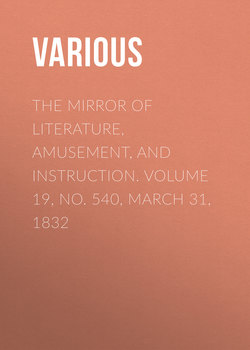The Mirror of Literature, Amusement, and Instruction. Volume 19, No. 540, March 31, 1832

Реклама. ООО «ЛитРес», ИНН: 7719571260.
Оглавление
Various. The Mirror of Literature, Amusement, and Instruction. Volume 19, No. 540, March 31, 1832
BANKSIDE.—OLD THEATRES
LACONICS
LEGAL RHYMES
FINE ARTS
THE NINTH EXHIBITION OF THE SOCIETY OF BRITISH ARTISTS
NOTES OF A READER
THE VEGETABLE WORLD
AMERICAN MANNERS
SPIRIT OF THE PUBLIC JOURNALS
THE COFFIN-MAKER
THE GATHERER
NOBLES OF JOHANNA
Отрывок из книги
The ancient topography of the southern bank of the Thames (or Bankside) between London and Blackfriars bridges is peculiarly interesting to the lover of dramatic lore, as well as to the inquirer into the sports and pastimes of our ancestors. It appears to have been the Arcadia of the olden metropolis, if such a term be applicable to a place notorious for the indulgence of brutal sports.
The Cut in the adjoining column represents Bankside in 1648, from which it appears to have been then in part waste and unenclosed. "It was land belonging to the crown, and on various parts of it stood the Globe Theatre, the Bear Garden, and other places of public show; here were also the Pike Gardens, some time called the Queen's Pike Gardens, with ponds for the preservation of fresh-water fish, which were said to be kept for the supply of the royal table, under the inspection of an officer, called the king's purveyor of pike, who had here a house for his residence."1 On the Bankside, prior to the above date, were also the ancient Bordello, or Stews, which, according to Pennant, were distinguished by their respective signs painted against the walls, one of which, in particular, was the Cardinal's Hat; and a small court, now or till lately called Cardinal's Hat Court, still exists on the Bankside, and probably shows the precise site of the mansion of depravity. In like manner we find on Bankside, Pike Garden, Globe Alley, and in the vicinity a public-house with the sign of the Globe. On Bankside also stood an ancient Hall and Palace of the Bishops of Winchester, stated to have been built by William Gifford, Bishop of Winchester, about the year 1107, on a piece of ground belonging to the Prior of Bermondsey, to whom was paid a yearly acknowledgment. The great court, at one time belonging to this palace, is still known by the name of Winchester Square, and in the adjacent street was, some time since, an abutment of one of the gates. Near this Palace, on the south, at one time stood the Episcopal Palace of the Bishops of Rochester; which is supposed to have bequeathed its name to Rochester Street. The whole of the Bank shown in the Cut is now densely populated, and scarcely a pole of green sward is left to denote its ancient state. On the opposite or Middlesex bank may be distinguished the celebrated Castle Baynard.
.....
It is also alluded to in some verses by Ben Jonson, entitled, "An Execration upon Vulcan," from which it appears that Ben Jonson was in the theatre when it was burnt.
This theatre was open in summer and the performances took place by daylight; the King's company usually began to play in the month of May. The exhibitions appear to have been calculated for the lower class of people, and to have been more frequent than those at the Blackfriars, till 1604 or 5, when it became less fashionable and frequented. Being contiguous to the Bear Garden, it is probable that those who resorted there went to the theatre, when the bear-baiting sports were over, and such persons were not likely to form a very refined audience.
.....